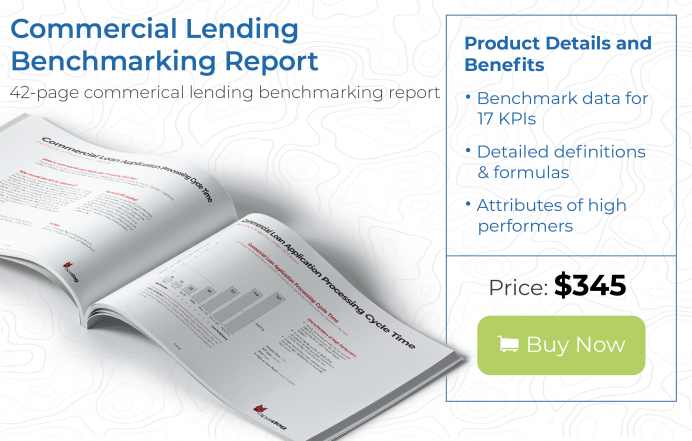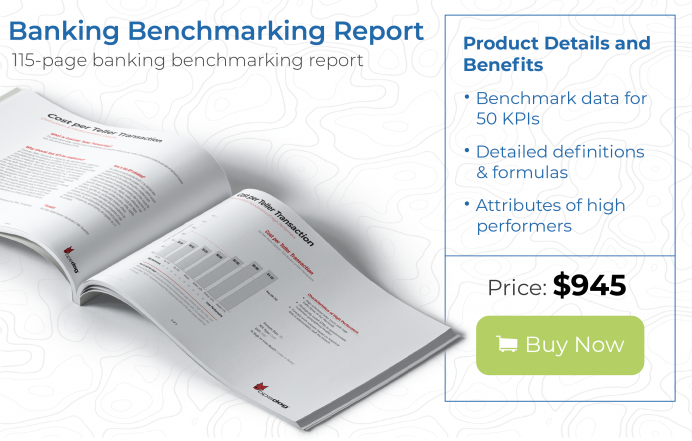“How much profit are we making on this loan?”
Seems like a simple question, but when it comes to commercial loans, it’s not an easy answer. Many lenders don’t have a good handle on their true profit margin on commercial loans. And in an environment with low-interest rates that squeeze margins and non-traditional competitors forcing lenders to waive fees, these loans can be a drag on earnings. Applying loan origination key performance indicators (KPIs) to commercial loans gives you a clearer picture of your actual loan origination costs.
What are Commercial Banking Loan Origination KPIs?
A commercial loan, sometimes called a commercial & industrial (C&I) loan, is any loan made to a business rather than an individual retail banking customer. These loans are big business for commercial lenders—accounting for roughly $3 trillion—and provide working capital for small and large firms. The loans are typically short-term of one to two years and backed by some sort of collateral.
Commercial loans are generally more complicated than mortgages and other types of consumer loans and can be more difficult to underwrite and price. As a result of this complexity, commercial loan origination costs can quickly get out of hand.
Commercial lenders are under increased regulatory scrutiny. You’ll need to spend more time and resources on compliance activities or risk huge fines, driving up origination costs. A lender that relies on manual processes, has a lot of touchpoints, or cannot close and fund loans quickly and efficiently can see any profits from origination fees disappear.
Commercial lenders that have invested in technology tend to have better loan origination key performance indicators (KPIs), especially when measuring end-to-end loan cycle time. They also tend to have more satisfied borrowers.
Benefits of Using KPIs in Commercial Banking Loan Originations
KPIs can help commercial lenders rein in origination costs. One of the biggest costs is staffing, including salaries, benefits, and bonuses. But if you downsize the workforce too much or hire lower-paid but less experienced loan officers and processors, you could negatively impact borrower satisfaction and lose future commercial business.
It’s all about balance and getting staffing levels right. But this can be difficult if you don’t understand loan officer and processor productivity. KPIs that measure how many borrowers each processor manages, how long it takes to close a loan, and even the average origination value of loans can indicate staffing problems.
Are higher-salaried loan employees handling administrative tasks? Automate those tasks or assign them to less experienced and lower-paid employees. Or perhaps staffing levels are appropriate, but employees are not well-trained or your procedures force them to have to reenter information or follow-up with borrowers. The fewer touchpoints, the better.
But costs also include employees not directly involved in processing loans. For example, with more regulatory oversight, lenders have had to hire non-revenue producing staff such as compliance officers.
Lenders also find that commercial lending KPIs can highlight shortcomings in their technology. Lenders may be using a dozen or more systems to usher the loan from application to close and funding. Integrating systems—or implementing a system that can manage commercial loans from start to finish—can go a long way in improving KPIs.
Many newer commercial lending systems incorporate workflows to manage loan volumes and make sure a loan doesn’t get stuck on someone’s desk. KPIs can help you decide if new technology is worth the cost and disruption.
Commercial Banking Loan Origination KPI Examples
Here are five commercial banking loan origination KPIs that can have a significant impact on lending profitability and borrower satisfaction.
KPI Metric #1: Commercial Loan Origination Cycle Time
Once a borrower submits their loan application, the clock starts ticking. The longer it takes to close and fund the loan, the more anxious and frustrated the borrower becomes. To improve the borrower experience, you’ll want to identify—and remove—any roadblocks that extend loan cycle time such as complex underwriting processes or confusing loan application requirements.
To calculate cycle time, divide the number of calendar days from loan application to loan close by the total number of commercial loan applications. Include weekends and holidays. If the closing and funding dates are different, use whichever date is later.
KPI Metric #2: Profit per Loan Originated
A combination of low-interest rates and an abundance of capital have made the profit margins on commercial loans razor-thin. It’s not uncommon for lenders to actually lose money during loan origination. The hope is to make up for this loss by cross-selling business customers with additional–and more profitable–commercial products and services.
To calculate, divide total loan origination profit by the number of loans originated.
KPI Metric #3: Cost per Commercial Loan Origination
How much it costs to originate and fulfill a commercial loan is critical to understanding lending performance and ultimately, profitability. Costs include staff costs such as salary, benefits, and bonuses, as well as overhead costs such as rent, technology, and vendor fees. For example, labor costs that are above industry benchmarks could indicate overstaffing or sub-par loan officer performance.
To calculate, divide the total commercial loan origination and fulfillment costs by the number of commercial loans closed and funded.
KPI Metric #4: Average Commercial Loan Size
The average size of a commercial loan is less than $200,000. However, large lenders tend to make larger loans that are often $500,000 or more. While bigger isn’t necessarily better, a larger loan amount typically increases profit margins. Average commercial loan size also gives you an idea of how effective your loan officers are in developing relationships with larger businesses.
To calculate, divide the dollar value of commercial loans originated by the number of commercial loans originated.
KPI Metric #5: Total Retail Branch Loan Production
Even though the term “retail branch” refers to consumers, many commercial loan officers work out of retail branch locations. Commercial lenders spend more time than retail lenders visiting customers at their business location, but they still rely on the branch as their home base. A strong commercial lending portfolio can increase the profitability of your branch network.
To calculate, divide the total dollar amount of commercial loans originated at retail branch banking locations.
Final Thoughts
Commercial lending profits are under pressure from historically low-interest rates, non-traditional lenders that provide borrowers with fast decisioning and funding, and regulatory burdens. To combat these headwinds, use commercial loan origination KPIs to identify cost-cutting measures and plug any efficiency leaks.
There are many key performance indicators for loans that should be taken into consideration, for a full list of lending process metrics download our Banking Key Performance Indicator Encyclopedia.
If you need additional help benchmarking against your peers or building a strong lending KPI library, then help yourself to our presentation-ready Commercial Lending Benchmarking Report, or contact us for more information about our benchmarking services. We can help you quickly and efficiently benchmark your lending operations and provide you with high-quality deliverables perfect for presentations at an affordable price.


